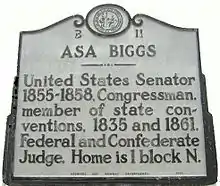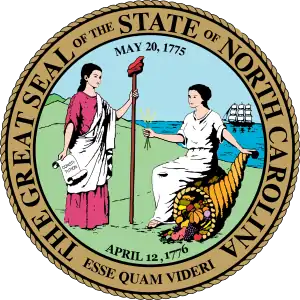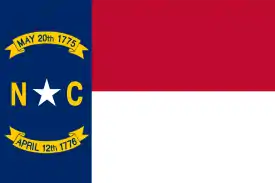Williamston, North Carolina
Williamston is a town in Martin County, North Carolina, United States. The population was 5,511 at the 2010 census. It is the county seat of Martin County.,[5] and is located in North Carolina's Inner Banks region. The closest major city is Greenville,[5] approx. 28 mi to the southwest.
Williamston, North Carolina | |
|---|---|
 Boardwalk along the Roanoke River in Williamston | |
| Motto(s): "Easy Living with Hometown Values" | |
 Location of Williamston, North Carolina | |
| Coordinates: 35°51′5″N 77°3′45″W | |
| Country | United States |
| State | North Carolina |
| County | Martin |
| Area | |
| • Total | 4.39 sq mi (11.38 km2) |
| • Land | 4.39 sq mi (11.38 km2) |
| • Water | 0.00 sq mi (0.00 km2) |
| Elevation | 72 ft (22 m) |
| Population (2010) | |
| • Total | 5,511 |
| • Estimate (2019)[2] | 5,202 |
| • Density | 1,183.89/sq mi (457.08/km2) |
| Time zone | UTC-5 (Eastern (EST)) |
| • Summer (DST) | UTC-4 (EDT) |
| ZIP code | 27892 |
| Area code(s) | 252 |
| FIPS code | 37-74220[3] |
| GNIS feature ID | 1023261[4] |
| Website | www.townofwilliamston.com |
Williamston was founded in 1779, and named after William Williams, a local military commander.[6]
Geography
Williamston is located at 35°51′5″N 77°3′45″W (35.851454, -77.062588).[7]
According to the United States Census Bureau, the town has a total area of 3.7 square miles (9.6 km2), all of it land. However, it is on the Roanoke River.
Some major highways are U.S. 13, U.S. 17, and U.S. 64.
Demographics
| Historical population | |||
|---|---|---|---|
| Census | Pop. | %± | |
| 1860 | 616 | — | |
| 1870 | 520 | −15.6% | |
| 1880 | 482 | −7.3% | |
| 1890 | 751 | 55.8% | |
| 1900 | 912 | 21.4% | |
| 1910 | 1,574 | 72.6% | |
| 1920 | 1,800 | 14.4% | |
| 1930 | 2,781 | 54.5% | |
| 1940 | 3,966 | 42.6% | |
| 1950 | 4,975 | 25.4% | |
| 1960 | 6,924 | 39.2% | |
| 1970 | 6,570 | −5.1% | |
| 1980 | 6,159 | −6.3% | |
| 1990 | 5,503 | −10.7% | |
| 2000 | 5,843 | 6.2% | |
| 2010 | 5,511 | −5.7% | |
| 2019 (est.) | 5,202 | [2] | −5.6% |
| U.S. Decennial Census[8] | |||
As of the census[3] of 2000, there were 5,844 people, 2,350 households, and 1,536 families residing in the town. The population density was 1,581.3 people per square mile (609.7/km2). There were 2,506 housing units at an average density of 678.2 per square mile (261.5/km2). The racial makeup of the town was 57.50% African American, 40.41% White, 0.29% Native American, 0.46% Asian, 0.09% Pacific Islander, 0.50% from other races, and 0.75% from two or more races. Hispanic or Latino of any race were 1.49% of the population.
There were 2,350 households, out of which 31.3% had children under the age of 18 living with them, 35.4% were married couples living together, 26.5% had a female householder with no husband present, and 34.6% were non-families. 31.9% of all households were made up of individuals, and 16.1% had someone living alone who was 65 years of age or older. The average household size was 2.38 and the average family size was 3.00.
In the town, the population was spread out, with 26.8% under the age of 18, 7.7% from 18 to 24, 23.2% from 25 to 44, 21.7% from 45 to 64, and 20.7% who were 65 years of age or older. The median age was 39 years. For every 100 females, there were 72.7 males. For every 100 females age 18 and over, there were 65.7 males.
The median income for a household in the town was $22,925, and the median income for a family was $32,984. Males had a median income of $28,661 versus $20,337 for females. The per capita income for the town was $14,125. 29.0% of the population and 22.8% of families were below the poverty line. 40.5% of those under the age of 18 and 28.6% of those 65 and older were living below the poverty line.
Culture
Williamston has long been a town centered around equine activity. Its logo showcases a horse and the town houses one of the largest agricultural centers in Eastern North Carolina - The Senator Bob Martin Agricultural Center. Many events including horse shoes, rodeos, tractor pulls, and monster truck shows take place in the Agricultural Center. Williamston also draws thousands of people to its annual "Carolina Country Stampede" each year in September which is a two-day festival showcasing local food, vendors, business owners and bands typically with a well known headlining band to end the Festival such as Emerson Drive in 2017.
Civil rights movement
Williamston was the focus of activity in the civil rights movement.[9] Beginning in June 1963, civil rights activists protested at City Hall for 29 consecutive days led by Golden Frinks.[9]
The Ku Klux Klan was very active in this part of the state during this time including a well-documented rally in Williamston on October 5, 1963 attended by mostly local residents but with several carloads of attendees traveling over 150 miles to attend.[10]
Notable people

- Asa Biggs, U.S. congressman from North Carolina and United States federal judge
- William E. Ingram, Jr., former director of the Army National Guard
- Gaylord Perry, Major League Baseball pitcher and member of the Baseball Hall of Fame
- Jim Perry, Major League Baseball pitcher
- Sarah J. C. Whittlesey (1824–1896), author, poet, hymn writer
References
- "2019 U.S. Gazetteer Files". United States Census Bureau. Retrieved July 27, 2020.
- "Population and Housing Unit Estimates". United States Census Bureau. May 24, 2020. Retrieved May 27, 2020.
- "U.S. Census website". United States Census Bureau. Retrieved 2008-01-31.
- "US Board on Geographic Names". United States Geological Survey. 2007-10-25. Retrieved 2008-01-31.
- "Find a County". National Association of Counties. Retrieved 2011-06-07.
- Federal Writers' Project (1938). The Ocean Highway: New Brunswick, New Jersey to Jacksonville, Florida. Works Progress Administration. p. 104.
- "US Gazetteer files: 2010, 2000, and 1990". United States Census Bureau. 2011-02-12. Retrieved 2011-04-23.
- "Census of Population and Housing". Census.gov. Retrieved June 4, 2015.
- Cunningham, David (2013). Klansville, U.S.A.: The Rise and Fall of the Civil Rights-Era Ku Klux Klan. Oxford University Press. p. 115. ISBN 978-0199752027.
- Cunningham, David (2013). Klansville, U.S.A.: The Rise and Fall of the Civil Rights-Era Ku Klux Klan. Oxford University Press. pp. 48–49. ISBN 978-0199752027.
External links
| Wikimedia Commons has media related to Williamston, North Carolina. |


